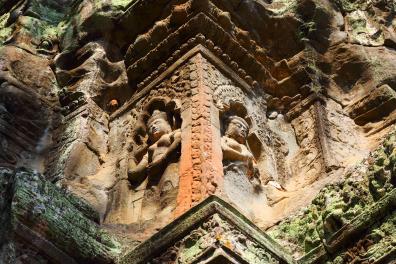Southeast Asia and Pacific
The Southeast Asia and Pacific (ASEP) department (which formed the Southeast Asia, High Asia and Pacific department until 2014) comprises 8 language sections, organized into 2 subsets: Southeast Asia and Pacific.

The ASEP department, whose domain extends from the border zones of southern China and the east of the Indian subcontinent to the Tropic of Capricorn, presents a linguistic, ethnic and cultural mosaic of Austroasiatics, Austronesians, Tai-Kadai and Tibeto-Burmans, with the dominant feature being the constant vitality of the original languages and cultures, always enriched, but never submerged, by the great currents of civilization that have influenced them.
India, China and the West have seen their cultural, linguistic and religious contributions integrated into the ancient fund to produce cultures where the philosophical speculations of Buddhism, Muslim and Christian fervor flourish, brahmanic heritage as well as the most concrete animist cults, the most refined poetry alongside the most realistic tales, where the oral and the written are constantly linked, where languages have sealed their originality with a script all their own. Diversity of peoples, languages and cultures - this is indeed the essential feature of South-East Asia and the Pacific zone, which political and economic current developments call for to play an increasingly important role in the years to come.
Languages taught
Bisaya (Cebuano), Burmese, Bislama, Cham (căm), Drehu (Lifou), Filipino (Tagalog), Ilocano, Indonesian-malay, Khmer (Cambodian), Lao (Laotian), Môn, Siamese (Thai), Tahitian, Taï lü and Vietnamese.
Courses
In the Southeast Asian field, the study of Burmese, Filipino, Indonesian-Malayan, Khmer, Lao, Siamese and Vietnamese can be done as part of the European bachelor's degree, as well as institutional diplomas. Bisaya and Ilocano are offered as introductory courses as part of the bachelor's degree or the Inalco diploma in Filipino. Cham is offered as an introductory course, and may be of particular interest to students of Vietnamese - central Vietnam is the cradle of the Chame civilization, and still has a Cham population - as well as students of Khmer - a large Chame minority living in Cambodia. Students of Indonesian-Malaysian, Filipino, Malagasy or Tahitian may also be interested in studying this language from the Austronesian family. An introduction to Môn - currently suspended - is of great interest to students of Khmer, as both languages belong to the same linguistic family, and to students of Burmese, as the Burmese script derives from Môn, and there is still a Môn state in the Burmese Union, but also students of Siamese, as a large part of present-day Thailand was inhabited by Môns before the arrival of Thai populations, and Môns have settled or resettled in Siam over the centuries. Students of Siamese and Lao particularly benefit from an introduction to the writing of Tai Lü.
In the Pacific field, Inalco offers a bachelor's degree or institutional diplomas with joint learning of Drehu and Tahitian, as part of a Oceanian curriculum. In the first year, a 1.5-hour introduction to Bislama is also offered as an advanced or introductory course (non-Austronesian Oceanic language).
Basic courses in each of the above languages can be taken as free UEs.
At Inalco, as part of the European license in the form of a license with a regional pathway (license LLCER), language teaching goes hand in hand with solid training in the culture carrying these languages, thanks to civilization courses covering fields as varied as history, geography, anthropology, the history of religions, economics, linguistics and more. Learning a language in the ASEP department can also be part of a bachelor's degree with a professional pathway in international business, communication and intercultural training, didactics of French as a foreign language, international relations and multilingual digital processing.
Finally, following a bachelor's degree in the ASEP department, Inalco also offers six master's courses (masters I and II) and a doctoral course.
Licenses
- Licenses in Langue Littérature et Civilisation Étrangères (LLCER) de filipino (Tagalog), indonésien (malais), khmer (cambodgien), lao (laotien) et siamois (thaï).
- License in Langue Littérature et Civilisation Étrangères (LLCER) de langues océaniennes (drehu et tahitien)
- License Université des Moussons double diploma Inalco-URBA (Manusastra program, licence LLCER khmer)
Access the licenses page
Masters
- Master in Langue Littérature et Civilisation Étrangères (LLCER) "Langues d'Asie du sud- estAsia and the Pacific"
- Master of Foreign Language, Literature and Civilization (LLCER) in Vietnamese
- Master of Foreign Language, Literature and Civilization (LLCER) in Manusastra (Khmer)
Access the masters page
School diplomas
- Diplomas in Language and Civilization (DLC) of Burmese, drehu, khmer, tahitian and vietnamese
- Diploma of Language and Civilization (DLC) "paroles, objets et cultures d'océanie (POCO)" of Burmese and tahitian
- Diplomas of Language (DL) of Burmese, drehu, Khmer and Tahitian
- Civilization Diploma (DC) of Oceania
Access the establishment diplomas page
Introductory courses
- The department offers introductory courses in Burmese, Indonesian, Khmer, Filipino, Siamese, Vietnamese.
These courses, which last a total of 52 hours spread over two semesters, can be accessed by enrolling in the new format (option 1 - 6 ects, 184€ for the year) offered by Passeport Langues O'. These introductory courses can also be chosen by students already enrolled in a bachelor's degree course as a free CE in UE4 from L2. - Bisaya and Ilocano are offered as introductory courses as part of the bachelor's degree or Inalco diploma in filipino.
Student mobilities
Contact Mr. Huy-Linh DAO, International Relations Manager for the ASEP department, and Mr. Thomas Françon, ASEP outgoing mobilities manager.
Department administration
Directors: Agnes HENRI, Dara NON